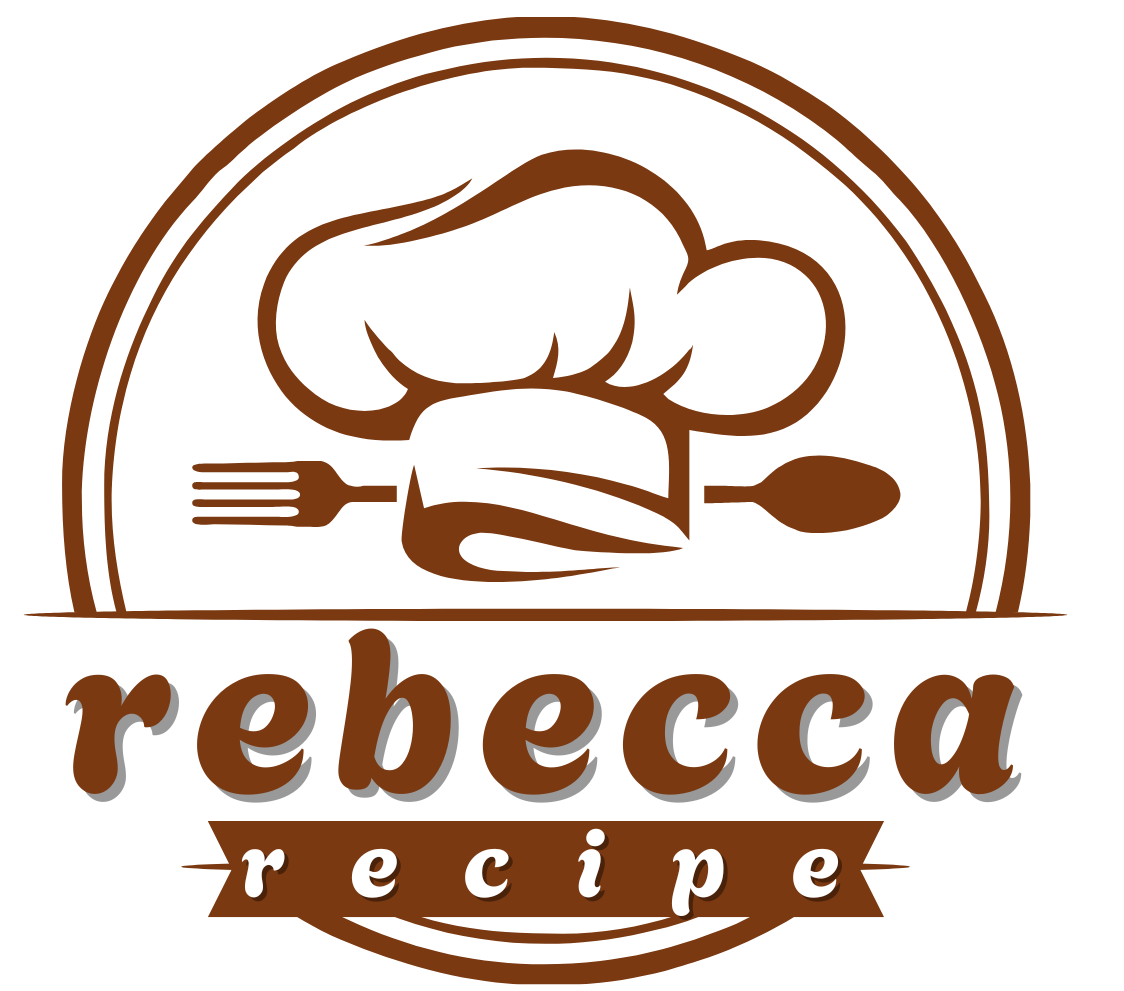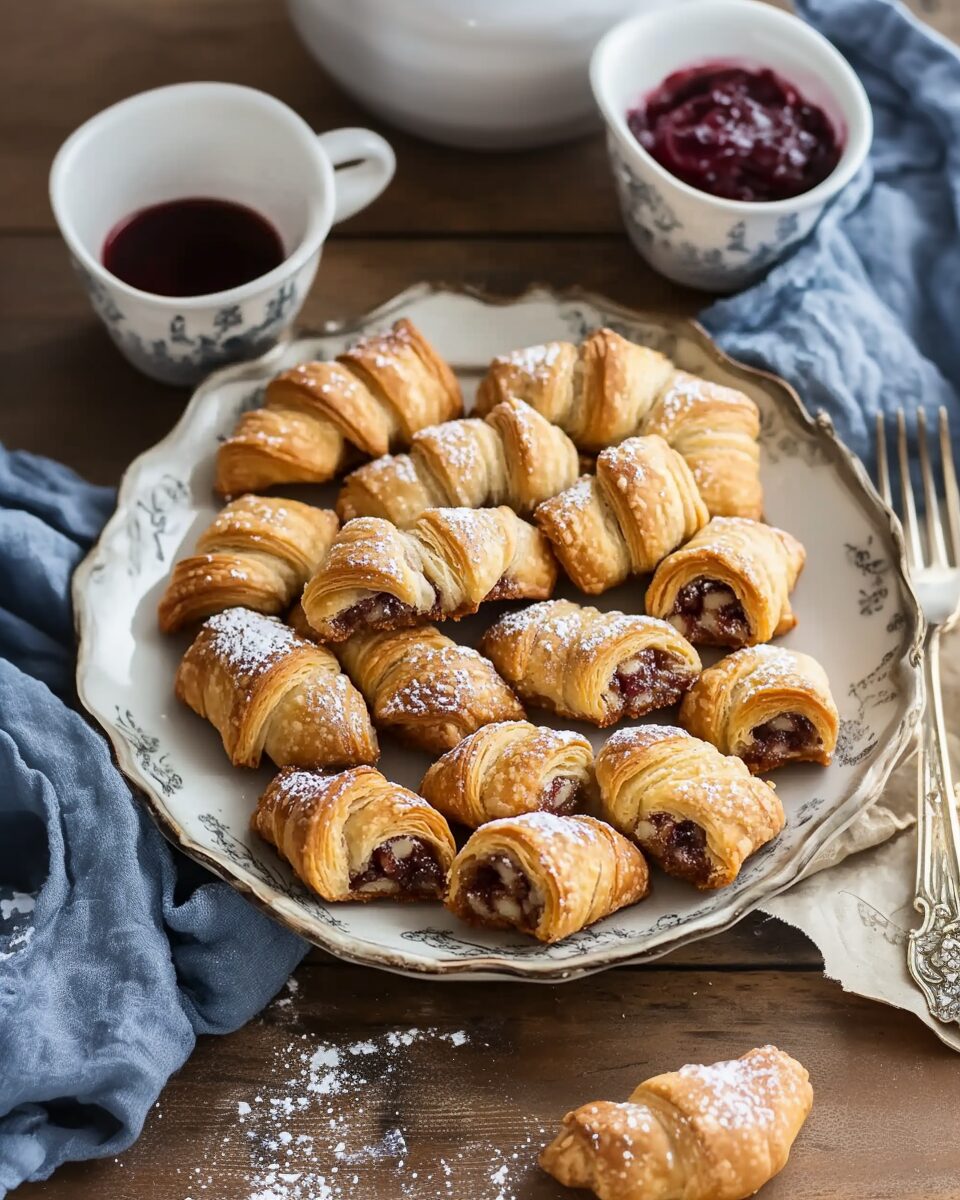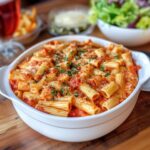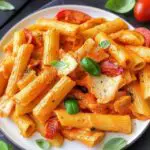Rugelach cookies are traditional Jewish pastries that have become beloved treats worldwide. These crescent-shaped delights feature a tender, flaky dough wrapped around a variety of sweet fillings, offering a delightful combination of textures and flavors. Often enjoyed during holidays and special occasions, rugelach are versatile and customizable, making them a favorite among home bakers and pastry enthusiasts alike.
Full Recipe:
Ingredients
-
All-purpose flour
-
Unsalted butter
-
Cream cheese
-
Granulated sugar
-
Salt
-
Vanilla extract
-
Assorted fillings (e.g., fruit preserves, chopped nuts, chocolate)
-
Egg (for egg wash)
-
Cinnamon (optional)
Directions
-
Prepare the Dough: Combine flour, salt, and sugar. Cut in cold butter and cream cheese until the mixture resembles coarse crumbs. Add vanilla extract and mix until a dough forms. Divide the dough into portions, shape into disks, wrap in plastic, and refrigerate until firm.
-
Roll and Fill: On a lightly floured surface, roll out each dough disk into a circle. Spread your chosen filling evenly over the surface.
-
Shape the Cookies: Cut the dough into wedges, similar to slicing a pizza. Roll each wedge from the wide end to the point, forming a crescent shape.
-
Bake: Place the shaped cookies on a baking sheet lined with parchment paper. Brush with an egg wash for a golden finish. Bake in a preheated oven until golden brown.
-
Cool and Serve: Allow the cookies to cool on a wire rack before serving.
Nutrients
-
Calories: 90–120 kcal
-
Carbohydrates: 12–15g
-
Protein: 1–2g
-
Fat: 5–7g
-
Saturated Fat: 3–4g
-
Sugar: 5–8g
-
Fiber: 0.5g
-
Sodium: 20–50mg
Historical Background
Originating from the Ashkenazi Jewish communities of Poland, rugelach have a rich history that intertwines with European pastry traditions. The name “rugelach” is derived from the Yiddish word meaning “little twists,” aptly describing their distinctive shape. Some culinary historians suggest a connection between rugelach and the Viennese kipferl, both crescent-shaped pastries. However, this link remains speculative, as both pastries predate the modern croissant and have unique cultural significances.
Etymology
The term “rugelach” reflects its Yiddish roots, with the suffix “-ach” indicating pluralization and the root possibly meaning “twist” or “corner.” This linguistic nuance highlights the pastry’s characteristic shape. Alternative theories propose that the name derives from words meaning “royal,” emphasizing the esteemed status of these treats within Jewish cuisine.
Cultural Significance
Rugelach hold a prominent place in Jewish celebrations and daily life. They are commonly prepared for holidays such as Hanukkah and Rosh Hashanah, symbolizing sweetness and joy for the coming year. Their presence at festive gatherings underscores their role in fostering community and tradition. Beyond Jewish circles, rugelach have been embraced globally, often featured in holiday cookie assortments and gourmet pastry selections.
Variations and Fillings
The adaptability of rugelach is evident in the myriad of fillings and dough variations employed across different regions and households. Traditional fillings include combinations of raisins, walnuts, cinnamon, and fruit preserves. Contemporary adaptations have introduced chocolate, marzipan, poppy seeds, and even savory ingredients like smoked salmon and cream cheese. Dough variations range from cream cheese-based recipes, popularized in American Jewish communities, to yeast-leavened and sour cream doughs, reflecting older European methods.
Preparation Techniques
Crafting rugelach involves a series of meticulous steps that contribute to their signature texture and appearance. The dough is typically rolled into circles, spread with the chosen filling, and then sliced into wedges. Each wedge is rolled from the wide end to the point, forming the characteristic crescent shape. Attention to detail during rolling and filling ensures even baking and a harmonious balance of flavors.
Serving Suggestions
Rugelach are versatile in their serving possibilities. They pair excellently with coffee or tea, making them ideal for breakfast or afternoon snacks. Their elegant appearance and rich taste also make them suitable for dessert platters at formal events. Serving them warm enhances their flaky texture and aromatic fillings, providing a comforting experience.
Nutritional Profile
While rugelach are indulgent treats, understanding their nutritional content can aid in mindful consumption. A typical rugelach cookie contains approximately 90–120 calories, with variations depending on size and filling. They provide carbohydrates for energy, modest amounts of protein, and fats, primarily from butter and cream cheese. Incorporating nuts or using whole grain flour can enhance their nutritional value by adding healthy fats and fiber.
Homemade vs. Store-Bought
While rugelach are widely available in bakeries and grocery stores, making them at home offers a more personalized and rewarding experience. Homemade rugelach allow for creative freedom in fillings and dough types, and often taste fresher and more delicate. Store-bought versions may prioritize shelf life and mass production efficiency, which can sometimes compromise the flakiness and richness of the pastry.
Pairing Ideas and Presentation Tips
Rugelach can be elevated by pairing them with various beverages or other desserts. Coffee, black tea, or sweet dessert wines complement the richness of the dough and the sweetness of the filling. For presentation, arrange them on a decorative platter, dust lightly with powdered sugar, or drizzle with melted chocolate for an extra touch of elegance. Their petite size makes them perfect for gifting or for inclusion in holiday cookie boxes.
Baking with Kids and Family
Rugelach are also a wonderful baking project for families and children. The hands-on process of rolling the dough and adding fillings invites creativity and fun in the kitchen. Involving children in traditional recipes like this can be an excellent way to pass down cultural knowledge and create lasting memories. Plus, the joy of seeing the final baked product adds a layer of excitement and satisfaction for young bakers.
Freezing and Storage Tips
One of the benefits of rugelach is their excellent storage potential. They freeze well, both before and after baking. Unbaked, shaped rugelach can be frozen and then baked directly from the freezer, extending their convenience for future occasions. Baked rugelach should be stored in an airtight container at room temperature for up to a week or frozen for longer-term enjoyment. This makes them ideal for advance preparation during the busy holiday season.
Conclusion
Rugelach cookies embody a harmonious blend of history, culture, and culinary artistry. Their evolution from traditional Jewish kitchens to global recognition speaks to their universal appeal. Whether enjoyed during festive occasions or as a daily treat, rugelach offer a delightful experience that bridges past and present, tradition and innovation. With countless variations, adaptable ingredients, and a rich cultural narrative, rugelach remain a timeless favorite in the world of baking.






